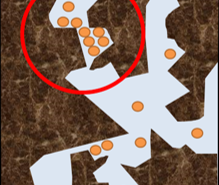Straining calculation
Straining, the physical filtration of particles in soils, is modelled similarly to attachment as an irreversible, first-order loss. There is thus a straining rate coefficient, but contrary to the case of attachment, this coefficient decreases as a function of depth. The idea is that particles will be less frequently found in dead-end pores if it is the case that overall, particles are being transported to deeper and deeper layers in the soil.
|
\(k_{straining}=\Psi k\)
|
\(k_{straining}\) is the straining rate constant and \(\Psi\) is the depth-dependent straining rate coefficient. \(k\) expresses the pseudo-first order rate of the interaction itself. This coefficient depends on the distance \(z\) from the origin/injection point of the nanomaterials in the porous medium and also on the average aggregate (collector) diameter \(d_{50}\). \(\beta\) is an empirical factor expressing the intensity of this depth dependence. |
Execution |
|
|
Straining is usually assumed to occur at the same time as other processes such as attachment. There is thus an assumption of a "second type of interaction site" where straining occurs. The straining rate constant itself, however, is a calibration constant fitted to column outflow experiments. Moreover, b is assumed equal to 0.43. |
Used in |
|
|
\(\theta \frac{dC}{dt}=v\theta \frac{dC}{dz}\) \(-\theta (\sum D )\frac{d^{2}C}{(dz)^{2}}\) \(-\Psi k_{straining} - k_{att}\) |
 Straining |
Read more |
Read also |
|
Consult the NanoFASE Library to see abstracts of these deliverable reports: |
Bradford, S.A., et al., Modeling Colloid Attachment, Straining, and Exclusion in Saturated Porous Media. Environmental Science & Technology, 2003. 37(10): p. 2242-2250 |
Contact

Geert Cornelis
Swedish University of Agricultural Sciences (SLU)
Email: geert.cornelis@slu.se
